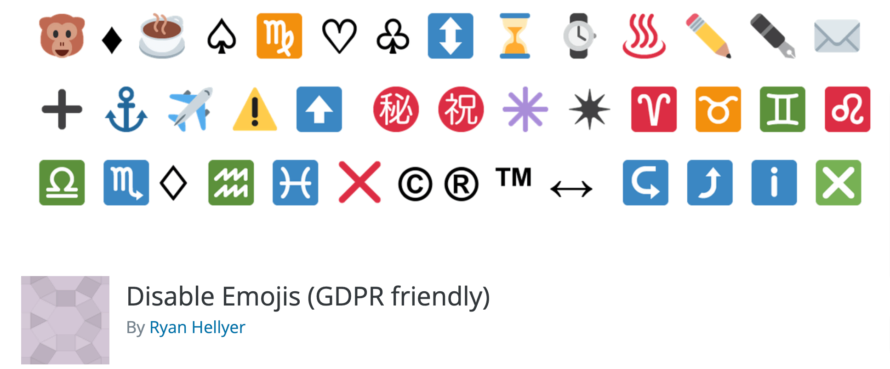Emojis are truly an enrichment for the online world. They liven up dry texts, underline what is said or written and are also a real eye-catcher.
However, the use of emojis is not always optimal for website performance.
In this article, we explain why this is so and which plug-ins help you to remove emojis from your website quickly and easily.
What are emojis?

Almost everyone knows them, but what exactly are emojis? The word “emoji” has its origins in Japanese and means something like “picture character”. As already mentioned, it can express emotions, but also represent activities.
Nowadays, the word has also made it into the Duden dictionary. It has the following definition: “Japanese emoticon-like pictogram that refers to emotions, objects, places, animals, food, etc. (in electronic messages)”.
Emojis are therefore an important and indispensable tool in digital communication. The Japanese designer Shigetaka Kurita is often named as the inventor of emojis. He designed several pictograms for a mobile phone provider at the end of the 1990s.
The small pictograms or ideograms (representing whole terms) are primarily used in chats and text messages. But they have also become indispensable in web design.
Difference between emoticons, smileys and emojis
You already know that emojis can express feelings, emotions, actions and activities. But how do emojis differ from emoticons and smileys?
Emoticons
Emoticons and emojis are often mistakenly equated. Emoticons are a combination of different letters, punctuation marks or special characters. They look something like this: :’) :’P :'(
You must know it, don’t you? 😉
Emoticons are, so to speak, the forerunners of emojis. The special thing about emoticons is that they have been around for more than 100 years.
Smileys
Smileys are the graphic representation of emoticons. If you type certain emoticons into your keyboard, some programmes automatically convert them into smileys.
Why should I remove emojis from my website?
Actually, one could now assume that emojis only bring advantages. Unfortunately, this is not the case.
Emojis influence your website performance
With the introduction of WordPress 4.2 in 2015, native support for emojis was also introduced. This means that scripts are included that support older browsers to display emojis. Nowadays, however, such scripts are obsolete, as almost all browsers support emojis by default. However, the CMS seems to care very little about this.
The use of emojis can lead to additional JavaScript being loaded. This can have the effect of slowing down the page loading time of your website.
Emojis and the GDPR
The integration of emojis can lead to data protection violations. This is the case, for example, if they are loaded from an external domain. A problem here is the risk of transferring personal data such as the IP address.
And this is exactly where the following plugin helps you so that you do not commit any data protection violations with emojis:
Disable Emojis (GDPR friendly)
The core function of the Disable Emojis (GDPR friendly) plugin is to disable the WordPress emoji support just mentioned.
So that we don’t misunderstand each other: The plugin does not remove emojis and emoticons, but the additional bloat code that is used to enable them to be displayed in very old browsers. Only visitors to your website who have not updated their computer or smartphone since 2013 at the latest will have problems.
One addition is the plugin’s data protection compliance. If you have read our article about ingenious GDPR plugins for more legal security in WordPress, you will already know this plugin.
Disable Emojis helps you to make your website compliant with the GDPR, as it disables DNS prefetching and loading of emojis within WordPress. This means that external servers are no longer involved.
Let’s now take a look at how exactly the emoji plugin works:
- Open your WordPress backend.
- Navigate to Plugins > Add New.
- Search for “Disable Emojis”.
- Install and activate the plugin.
- Done! Disable Emojis now automatically removes the unnecessarily loaded scripts.
An alternative to Disable Emojis is the plugin Autoptimize. The difference between this and Disable Emojis is that, in addition to deactivating emojis, it also provides other functions to optimise the loading time of your website.
Alternatively, you can deactivate the emojis directly in the code of your website, in the function.php. However, this is the less beginner-friendly alternative. In addition, you can damage a lot of your website. If programming is completely new territory for you, you should therefore leave it alone.



